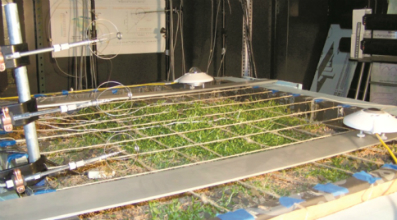Pennsylvania State University - Modelling and Measuring Green Roof Thermal Performance
Published: Thursday, August 16, 2012
The thermal performance of green roofs has been studied worldwide using three different approaches; field experimentation, numerical studies, and a combination of laboratory or field experiments with numerical models. All the reviewed studies concluded that green roofs can reduce the heat flux from buildings.
However, design engineers do not have a standard calculation procedure or a tool to calculate energy savings from green roofs. Therefore, Pennsylvania State University has spent seven years developing an accurate model to predict the thermal resistance “R” value of a green roof. These “R” values represent a set of equations from the model that could be implemented in energy simulation programs commonly used in building design practice.
In the summer of 2003 researchers began construction of a number of green roofs for laboratory testing of their thermal properties. The example pictured above is constructed to simulate a green roof on a typical brick-built structure. From bottom to top this construction includes plywood sheathing, a water-proof membrane, a drainage and filtering mat, 3.5 inches of growing medium, and plants.
Two plants, Sedum spurium and Delosperma nubigenum, were chosen to examine how the choice of flora affects the thermal performance of green roofs. Analysis of previous research and theoretical formulations led researchers to conclude that the R-value will likely be a function of the current weather conditions, the type of plant, and the type of construction. The same analysis showed that the best way to control the wide set of weather parameters is to establish the roof in an environmental chamber, thus eliminating the non-steady state conditions present in field experimentation.
A new test apparatus was required to be able to measure all of the important physical parameters affecting the performance of green roofs, a task not done previously due to the complexity of the phenomena involving plants, growing media and weather conditions. The new apparatus utilises an environmental chamber for thermal property tests. Inspired by ASTM standards C177 and C1363, which respectively govern hot plate and hot box tests for thermal properties, researchers developed a cold plate box which would rely on the chamber to serve as a heat source.
 The picture on the left shows Kipp & Zonen’s CMP 21 pyranometer & CGR 4 pyrgeometer being used to measure the heat source. The source can be suspended at various heights above the green roof samples to simulate varying amounts of solar radiation. The remaining meteorological properties (air temperature, wind velocity, and relative humidity) can be set using the control systems of the chamber in combination with appropriate air supply diffusers.
The picture on the left shows Kipp & Zonen’s CMP 21 pyranometer & CGR 4 pyrgeometer being used to measure the heat source. The source can be suspended at various heights above the green roof samples to simulate varying amounts of solar radiation. The remaining meteorological properties (air temperature, wind velocity, and relative humidity) can be set using the control systems of the chamber in combination with appropriate air supply diffusers.